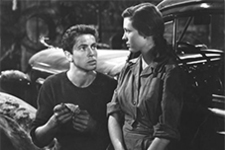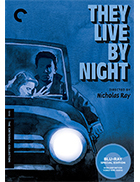They Live by Night
|  In Nicholas Ray’s auspicious feature debut The Live by Night, two innocents who know little about the world except that they don’t have a place in it, find themselves on the lam in what we know is a tragic attempt to outrun fate. It is a fascinating film—a cross-pollination of the romantic melodrama and film noir—that established Ray’s reputation as an innovative, outsider artist with a strong bent toward romantic fatalism and sympathy for outcasts (the conflict with the Hollywood studio system, which would come to define his career, was already evident here, as Howard Hughes, who had taken over RKO in 1948, delayed its distribution for nearly two years). The two leads, Cathy O’Donnell and Farley Granger, were both young and beautiful and relatively new to the silver screen, and they lend to the violent story an aura of genuine innocence that creeps toward, but never gets mired in, mawkish sentimentality. The film’s harder edges are softened, but not dulled, by their lack of guile. The story begins with Farnsworth’s character, a young man named Bowie who has been in prison since he was a teenager (he was unfairly sentenced for murder), having just escaped from a Texas prison (probably Huntsville) with two seasoned cons, Chichamaw (Howard Da Silva) and T-Dub (Jay C. Flippen). They were aided in their escape by Mattie (Helen Craig), T-Dub’s sister-in-law who wants them to rob a bank to help her pay her husband’s way out of prison. Bowie is willing to go along mainly because he believes he can use the money to pay a lawyer in Tulsa to overturn his conviction. Chichamaw, the most violent and unhinged of the threesome, has a brother named Mobley (Will Wright) with whom he has stashed enough money to fund the impending robbery. They hide out at Mobley’s service station, which is where Bowie meets Keechie (Cathy O’Donnell), Mobley’s daughter. They are instantly attracted, perhaps because they both recognize in the other a fundamentally gentle soul despite all appearances to the contrary. Keechie has spent her entire life helping and protecting her aging, alcoholic father, and she has a guarded presence that is just waiting to come down, while Bowie’s criminality is little more than a survival skill, not his essence. After Bowie, Chickamaw, and T-Dub successfully knock off a bank, the latter two men make off with their share of the cash while Bowie runs off with Keechie in the hopes that they will be able to make a “normal” life for themselves. The second half of the film follows them as they move through the countryside, hiding out in campgrounds and roadside motels after a spontaneous decision to get married at a quickie chapel. They play at normality, fashioning a little home in a cheap cabin in the woods and going out for a day on the town where they marvel at horseback riding and golf, but Bowie’s criminal past is always lurking around the edges, threatening to re-emerge and drag him back into it. The screenplay by Charles Schnee (Red River), which he wrote from Ray’s adaptation of Edward Anderson’s 1937 novel Thieves Like Us (which Robert Altman also adapted in 1974), makes fantastic use of the road movie structure, which was becoming more and more popular at the time with the rise of automobile ownership and highway construction. The romanticism of the open road—with its existential invocation of open freedom—suffuses the film throughout, as Bowie and Keechie spend much of the film traveling, although they never seem to actually get anywhere. They talk of escaping to Mexico at one point, but there is a circularity to their progress that foreshadows doom. There are moments of happiness, when it seems like Bowie and Keechie are the only people in the world and nothing can stop them, but these are fragmented and temporary, always circumscribed by Bowie’s criminal ties and their combined lack of worldly experience (the film opens with a close-up of them together with a subtitle informing us “This boy … and this girl … were never properly introduced to the world we live in”). With their soft faces and bright eyes, O’Donnell and Granger are perfectly cast as true lovers in a corrupt world; she had previously starred as Wilma Cameron, the fiancée of a disabled war veteran in The Best Years of Our Lives (1948), while Granger had only starred in two Lewis Milestone-directed war films The North Star (1943) The Purple Heart (1944), although he would achieve infamy over the next few years with roles in Alfred Hitchcock’s Rope (1948) and Strangers on a Train (1951). They Live by Night, which French critic François Truffaut called “unmistakably [Ray’s] best film” in the pages of Cahiers du cinema in 1955, regularly shows up on lists of greatest film noir, partially because it was such an influential addition to the genre in the way it diverged from the hard-boiled detective-centered noir, focusing instead on a tragic romance set against the backdrop of criminal desperation. Bowie is not the typical hardened protagonist; in fact, he is often seen in a state of injury or weakness, originally sidelined from the opening getaway by a sore foot, slapped around by T-Dub when he tries to back out of a second bank robbery, and severely injured in a car wreck. The film draws on the lovers-on-the-run subgenre that arguably started with Fritz Lang’s You Only Live Once (1936), and it was one of a number of films noir in the late 1940s and early ’50s, including Detour (1945) and Gun Crazy (1950), that moved out of the cities and into the country, which opened up the genre and redefined the pastoral in much starker terms. Ray and cinematography George E. Diskant, an RKO contractor worker who had only shot a half-dozen undistinguished features at that point, pepper the film with classical noir lighting strategies and cramped compositions (especially when Keechie first meets Bowie, and the top half of her face is completely shrouded by the shadow of her hat), but also give the film its own unique look. Ray, who had worked with the Federal Theatre Project during the Great Depression and had developed relationships with the architect Frank Lloyd Wright, dramatist Thornton Wilder, folklorist Alan Lomax, and director Elia Kazan (with whom he worked as an assistant on 1944’s A Tree Grows in Brooklyn), was a genuine iconoclast who was willing to experiment and push boundaries, which we see in They Live by Night’s surprising use of helicopter shots, creative sound design, and assuredness in mixing hardened violence with sincere romanticism (as Truffaut rightly noted, “Ray’s very great talent resides in his absolute sincerity, his acute sensitivity”). The result is a truly unique film—a groundbreaking entry in a distinctly American genre that announced in no uncertain terms the arrival of a major new talent.
Copyright © 2017 James Kendrick Thoughts? E-mail James Kendrick All images copyright © The Criterion Collection | |||||||||||||||||||||||||||||||
Overall Rating: 


 (4)
(4)


